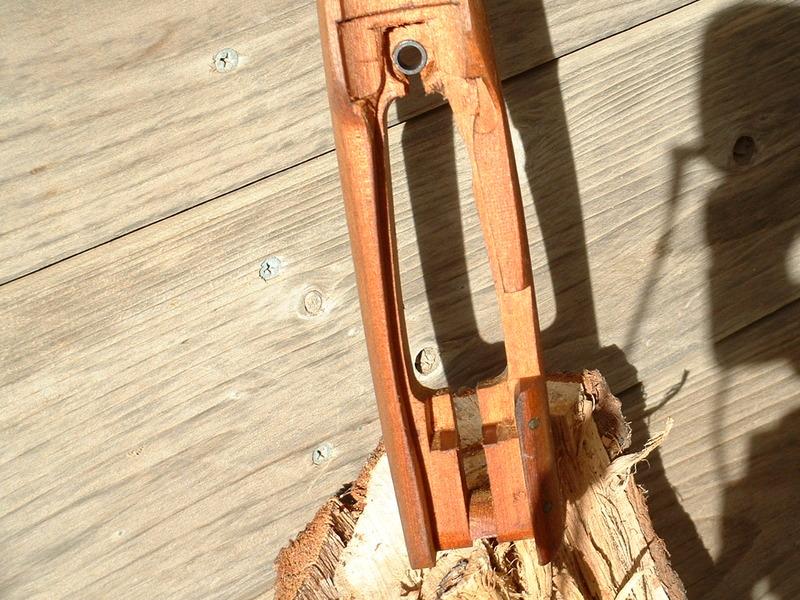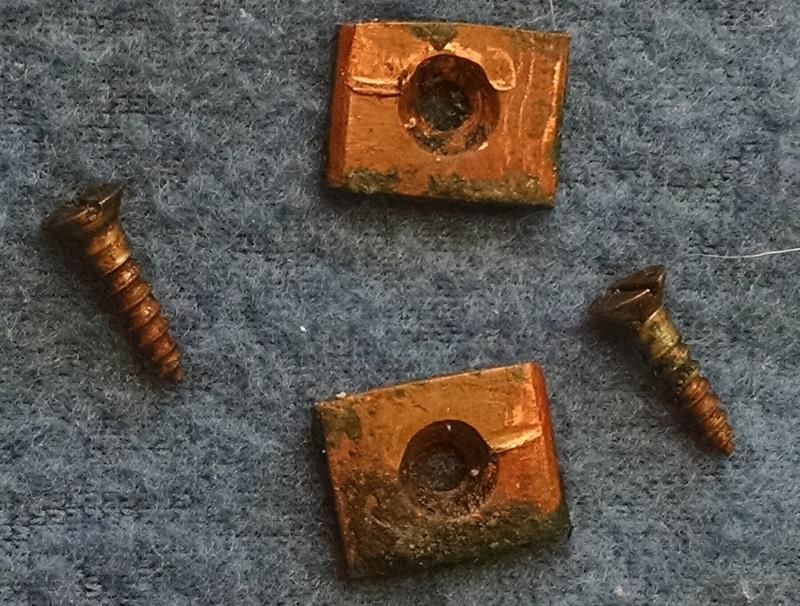-
Sons thread and photos do show the WIDER copper plates but this amply illutsrates a couple of points that I couldn't mention because I don't have a fore-end handy. The wider plates ARE wider but is that simply because if they weren't wide, you'd never(? or hardly without totally weakening) get a wood screw countersunk head into the plate! And no matter how you put it, the rearward loading in that situation goes straight down through and into the wood where the drawers sit, tilting the copper block as it does so.
I had a funny feeling that this would run as soon as I put pen to paper.
Here's another question chaps........ How do you repair a copper blocked fore-end when there's end float? Bin it and get a new one, put thicker copper blocks in place and plug and re-screw the screw hole or just wood patch in the usual manner observed amongst Armourers
-
Thank You to Peter Laidler For This Useful Post:
-
03-29-2017 11:02 AM
# ADS
Friends and Sponsors

-
Legacy Member

Peter to your first question, I would respond, when properly fitted, there's no allowable movement between action and wood, so the plate can't tilt.
Second question, I'm interested to know also if there is some kind of armorers instruction to repair end play. To be honest, I haven't come across any coachwood forends with recoil plates that presented any noticable end play with the action. I'm inclined to think the harder copper plates almost completely remedied the problem of wood compression from bruising directly behind the bearing surfaces.
Last edited by Homer; 03-29-2017 at 03:24 PM.
-
Thank You to Homer For This Useful Post:
-
-
Ah, but we're not talking about when the fore-end is nicely fitted with plates. Then of course there ISN'T a problem. We're asking about when end float in the taper between the butt socket and drawers takes place.
The NZ Army repair at the huge Base workshop facility where I was based* was to remove the fore-end, remove the blocks and screws, simply machine out the worn drawers, wood patch, re-fit and send back out again or return the weapon to Ordnance. Exactly as we, the NZers, Australians et al had been doing for 40 years BEFORE the introduction of copper seating blocks and we've been doing for 70 years since on No4's. Same meat, different gravy of course. Indeed......, Son has shown photos of such repairs
Army repair at the huge Base workshop facility where I was based* was to remove the fore-end, remove the blocks and screws, simply machine out the worn drawers, wood patch, re-fit and send back out again or return the weapon to Ordnance. Exactly as we, the NZers, Australians et al had been doing for 40 years BEFORE the introduction of copper seating blocks and we've been doing for 70 years since on No4's. Same meat, different gravy of course. Indeed......, Son has shown photos of such repairs
*I'm just telling you what my boss told me and as I also mentioned, while there were some old No1's still doing the rounds they weren't something that I was working on. My job was war preparation in-inspection stuff
-
The Following 4 Members Say Thank You to Peter Laidler For This Useful Post:
-
Advisory Panel


I have a foreend somewhere where the recoil plates have turned in toward the center pivoting around the screw just as Peter suggested might happen. That particular foreend is well and truly drenched with oil that has probably run back from the barrel when over oiled and racked upright. The coachwood has turned into soggy mess just like the worst of the walnut ones we have seen, allowing the part supporting the inside edge of the copper plates to compress. Of course, once any movement is present, the damage gets very bad very quickly.
I would suggest this is avoidable, and therefore the exception rather than the rule with well kept, tight fitting coachwood foreends fitted with the copper plates.
As for tightening them if they do get loose... I cannot say I have ever came across any that were loose that did not show a good reason for being loose. Tell-tales like the square in the tie plate spread and burred from having the butt screw moved while the foreend is attached. This spreads the tie plate, and cracks and spreads the back of the foreend, stripping the grip of the threaded cross wire at the back, allowing the foreend to spread freely and loading the copper recoil plates more toward the inner edge as the gap between them is opened. The draws cracked out along the screw holes- pic below.
I have, on a foreend I have fitted plates to (and didn't get right first go), used shim material behind the plates to get them to even tension again. Another I did was on a H barreled range rifle that looked to have had the foreend removed by pulling down at the front first instead of tapping off at the rear. Luckily the motion seemed to only compress the draws slightly and few thou of shim each side tightened them up.
Attachment 82313
-
The Following 2 Members Say Thank You to Son For This Useful Post:
-
FREE MEMBER
NO Posting or PM's Allowed

[QUOTE=Peter Laidler ;395801]Ah, but we're not talking about when the fore-end is nicely fitted with plates. Then of course there ISN'T a problem. We're asking about when end float in the taper between the butt socket and drawers takes place.
;395801]Ah, but we're not talking about when the fore-end is nicely fitted with plates. Then of course there ISN'T a problem. We're asking about when end float in the taper between the butt socket and drawers takes place.
The NZ Army repair at the huge Base workshop facility where I was based* was to remove the fore-end, remove the blocks and screws, simply machine out the worn drawers, wood patch, re-fit and send back out again or return the weapon to Ordnance. Exactly as we, the NZers, Australians et al had been doing for 40 years BEFORE the introduction of copper seating blocks and we've been doing for 70 years since on No4's. Same meat, different gravy of course. Indeed......, Son has shown photos of such repairs
Army repair at the huge Base workshop facility where I was based* was to remove the fore-end, remove the blocks and screws, simply machine out the worn drawers, wood patch, re-fit and send back out again or return the weapon to Ordnance. Exactly as we, the NZers, Australians et al had been doing for 40 years BEFORE the introduction of copper seating blocks and we've been doing for 70 years since on No4's. Same meat, different gravy of course. Indeed......, Son has shown photos of such repairs
*I'm just telling you what my boss told me and as I also mentioned, while there were some old No1's still doing the rounds they weren't something that I was working on. My job was war preparation in-inspection stuff[/QUOTE
Which begs my next question. If the copper blocks were no better at withstanding recoil, perhaps they may have reduced the number or frequency of rebuilds in the draws area?
-
Advisory Panel


I honestly think the coachwood furniture was accepted as being no better than Qld maple for the task, but perhaps the easiest wood to machine and control as far as warping was concerned.... Maybe it's good points (compared to what was available in the absence of good English or Spanish walnut) outweighed the bad, and seeing it was during WW2 by then, any attempted fixes were limited to working with what you already had....
just my 2c
-
The Following 3 Members Say Thank You to Son For This Useful Post:
-
Legacy Member

Fitting copper plates at the factory would have been quicker ,easier, cheaper than finding the skill to fit hardwood blocks when numbers out the door was the name of the game. We are seeing the ravages of time etc which is also unkind to all other for-ends. The luxury of more time in workshops when repair was needed could be used because the numbers were up from the Factory. Obviously without the plates the work load at base workshops was too high not enough rifles going out the door to replace those coming in the door. Solution fit copper plates win win and some think they are hard done by because these old ladies need a little TLC and repair. The Aussie soldier would have been much happier knowing his rifle was going keep doing what it should do when needed.
-
-
Contributing Member


I agree Bindii, it was all about economics and repair turnaround.
I do have pics on another computer that show a more substantial wood patch.
Brad, the oil soak syndrome probably had a lot of bearing on the copper block usage, being more able to protect the timber.
We must remember that other methods had been trialled before this, the solid rods of 1934-35, which though effective, did not last long.
Then there were the aluminium blocks of the '50's. followed by Joe Wards patent 12132/52 which used adjustable threaded rods as per the 34-35 modification.
This allowed the slack to be adjusted as required.
As per the fitting of blocks to forewoods, the question would be was the production standards of the time good enough that these blocks were prefitted to all forewoods before the timber was mated to the firearm? If it was then there would be a high volume of forewoods complete with plates to be used up before exhausting the supply and reverting to bare timber.........just a thought, as the quality of the early coachwood was pretty good.
-
Thank You to muffett.2008 For This Useful Post:
-
Legacy Member

;)
Great read on a much overlooked subject. 


MJ, don't take this personally, but that's crap.
muffett.2008

-
















 PM
PM













